Stylised Talk: Writing Great Dialogue [With Examples]
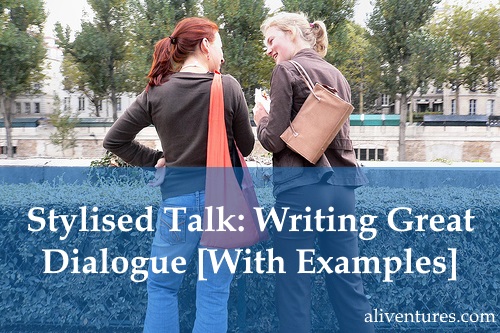
Image from Flickr by procsilas
This post was first published in August 2015, and updated in February 2019.
If you’re a fiction writer, unless you’re writing a very short story or something decidedly experimental, you’re going to have to write dialogue.
For some writers (me included), dialogue comes easily. It may even be a little too easy – sometimes, the first words you think of aren’t necessarily the best. Other writers don’t like dialogue, but they recognise it’s an essential part of their story.
Great dialogue can immerse the reader in your book, your world, and most especially your characters.
Poor dialogue jars the reader, and may even see them put the book down in frustration.
If you need a quick refresher on the basics of dialogue before we get going, here are a couple of links. They’ll open in a new tab so you don’t lose your place here:
- Formatting Dialogue: A Quick and Dirty Guide (goes step-by-step through the rules of setting out dialogue on the page)
- 9 Easily Preventable Mistakes Writers Make with Dialogue (a guest post on The Creative Penn by yours truly – a bit of overlap with this post, and some examples of the various mistakes)
Here, I want to dig deep into what makes for great dialogue … and what holds writers back.
What I Aim for When Writing Dialogue
Dialogue is stylised talk. It should give a flavour of real speech, without seeking to recreate it on the page. (Record and transcribe a normal conversation: you’ll be surprised how incoherent it looks written down, even if it sounded just fine spoken.)
In my writing, my aim is to tell the story without letting the words get in the way. That applies to the dialogue just as much as it does to everything else.
I want my dialogue to be natural and believable, so it could work in a TV or film script.
But …
This is far from the only way to write good dialogue. There are plenty of authors who things differently – and I’m going to come on to some examples in a moment.
Obviously, your dialogue needs to gel with the style of the rest of your work. If you have very prosaic, ordinary dialogue but the rest of your novel is much richer and more literary in style, that’s going to be a weird disconnect.
Three Examples of Different But Great Dialogue
The Children’s Book (A.S. Byatt) – natural-sounding historical
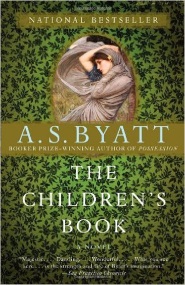 Get it from Amazon.com / Amazon.co.uk
Get it from Amazon.com / Amazon.co.uk
I’m about ten chapters into A.S. Byatt’s The Children’s Book at the moment. (No spoilers, please!) From the first few pages, I’ve been impressed how the dialogue seems unstrained and natural – despite feeling appropriate for the period (late 19th century).
Here are a couple of brief excerpts:
“I said I’d show you a mystery.”
“I thought you meant one of the treasures.”
“No. I meant him. There’s something shifty about him. I’ve been keeping an eye on him. He’s up to something.”
(From near the start of Chapter 1)
“My fault,” said Dorothy. “All my fault. Are you hurt?”
“Don’t think so, no. Winded.”
He began to laugh.
“What’s funny?”
“There are things in the country that smell quite as foul as things in the town. Only vegetable foul, not smoky. I’ve never smelt anything in the least – like this.”
“It’s wild garlic. It isn’t very nice.”
(From Chapter 2)
Now, I couldn’t tell you how people really spoke in the 1880s – but to me as a reader, this seems authentic. It doesn’t distract me from the story by sounding stilted. It’s easy to connect with.
The Importance of Being Seven (Alexander McCall Smith) – poised and stylised but works
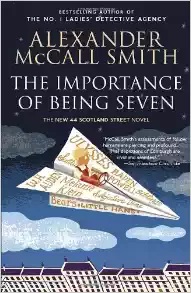 Get it from Amazon.com / Amazon.co.uk
Get it from Amazon.com / Amazon.co.uk
If you’ve read any Alexander McCall Smith, you’ll know he has a uniquely gentle style. His dialogue is generally a softer, more precise version of what I’d normally expect … but it works. Of course, he uses plenty of the features you might expect, like interruptions and ellipsis, where appropriate too.
Here are a couple of excerpts:
“Do you know anybody who has an Aga?” she had asked Matthew after that conversation with his father.
“Hundreds,” said Matthew. “Why?”
Elspeth frowned. “Do you really know hundreds of people who have one?”
Matthew nodded. “Yes. I thought they were pretty common. They’re very nice things, you know. They make for a lovely warm place. You can put your wet washing on the rail, socks, underpants, the works. They get dry in no time.”
(From Chapter 2)
Angus rolled his eyes. “I can’t believe I’m hearing this from you, Lou. These women with their cosmetic surgery …”
“And men,” interjected Big Lou. “Men go in for it too. I saw a film, about men who were anxious about …”
“Yes, yes,” said Angus hurriedly. “That may be so. But you see the results on the women. Those awful tightened faces that end up looking like Japanese Noh masks. All the character taken out of the face. Just this tight nose. It’s ghastly.”
(From Chapter 19)
None of the dialogue is out-of-character (Matthew is a young, recently-married man, but he’s upper-class, for instance) – but neither would it fit seamlessly into a faster-paced, more conventional novel.
The Girl Who Couldn’t Read (John Harding) – unusual, highly characterful dialogue and narrative
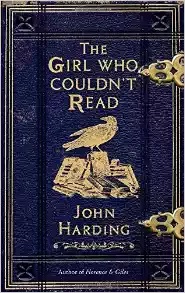 Get it from Amazon.com / Amazon.co.uk
Get it from Amazon.com / Amazon.co.uk
One of the characters in this book, “Jane Dove”, an inmate in an 1890s asylum, has a particularly unusual way of speaking at times. Here are a couple of examples:
We sat in silence once more and then I said, “What have you been doing with yourself all morning? Are you not bored?”
“It is better than day-rooming it with the others.”
“You prefer being alone?”
She smiled. “I prefer armchairing to benching.”
(From Chapter 10)
“I have told you it is unallowed. My uncle loved a woman who got herself all booked and cultured up and surpassed him in both and then someone-elsed.”
(From Chapter 26)
This is obviously a fairly extreme form of giving characters distinctive speech patterns – see tip #1, below. But as the narrator, John Shepherd, notes, there’s a consistency in the way Jane speaks – her unusual language is not the babbling of a madwoman. It’s well-conveyed in the dialogue, and not overdone. (If you want more in this style, see Harding’s Florence and Giles, which is a prequel of sorts.)
I’m sure you have a whole bunch of examples from your own reading of different ways of approaching dialogue … all of which work. (Do drop a comment below to tell me some of the novels or short stories you love for their great use of dialogue.)
So, please don’t take the following list as being a set of rules that must be followed. Instead, use them as possibilities for making your own dialogue stronger – which may well involve a few small tweaks rather than wholesale re-writing.
Six Tips for Making Your Dialogue Stronger
#1: Make Your Characters Sound Different from One Another
 Real people don’t all talk in the same way. Just think of the people you know. Probably:
Real people don’t all talk in the same way. Just think of the people you know. Probably:
- Some of them seem to swear every other word; others never utter anything stronger than “gosh”.
- Some use more complex words than others – think “paraphernalia” vs “stuff”.
- Some tend to go on a bit; others don’t say much.
- Some will have particular phrases that you associate with them – verbal tics.
The way people speak can clue you into their age, gender, class, geographical background, and level of education. You don’t necessarily have to bow to stereotypes here – you might have a teenager who eschews swear words and uses quite formal language, for instance.
Also, breaking a pattern can be powerful. If someone who rarely says more than two words delivers an impassioned speech, or someone who never swears turns the air blue, readers will take notice!
Watch Out For…
When you’re deciding how your characters speak, there are a couple of things to be a little cautious of:
Catchphrases – for me, these fall into the category of character “quirks” – they’re handy for bit-parts but don’t really go deep enough for main characters. By all means, give your characters the occasional phrase that is associated with them, but don’t go over the top here.
Phonetic spellings – steer clear or use a very light touch. It’s really easy for this to become both unreadable and insulting to real people who share the same geographical or racial background as your character.
#2: Don’t Over-Explain
 I’ve learnt this one the hard way (and many thanks to Lorna, my lovely editor, for all her help and patience…)
I’ve learnt this one the hard way (and many thanks to Lorna, my lovely editor, for all her help and patience…)
Your readers are experienced. Yours is not the first novel or short story they’ve read. In their lifetime, they’ll have read millions of words of fiction.
They’re also experienced in talking and listening. They understand things like sarcasm and subtext. They know that the same short phrase can mean wildly different things from different people in different contexts.
As much as possible, let your dialogue stand up by itself. Don’t throw in extra lines of explanation to ensure that the reader gets a joke, or understands the emotion behind the dialogue.
(Incidentally, this is one key reason to workshop your novel-in-progress, or to use beta readers or an editor: they’ll let you know when you do need to add a few extra words of explanation.)
Watch Out For…
Telling us how a character is feeling. We should be able to tell from the dialogue (plus supporting action – do they stand up, sit down, turn away, gesture…?)
Unclear attributions. You’re not over-explaining just because you’re making it clear who’s speaking. An extra “he said” or a line of action along with the dialogue is fine.
#3: Give the Flavour of Real Speech
 In real life, people don’t speak in perfect sentences, taking it in turns to talk. They ramble, they cut in, they talk over one another, they mumble inaudibly, they break off part way.
In real life, people don’t speak in perfect sentences, taking it in turns to talk. They ramble, they cut in, they talk over one another, they mumble inaudibly, they break off part way.
Where appropriate, introduce some of this into your fiction. For instance, if emotions are running high, characters may well interrupt one another. If people are excited, they might talk over one another.
(You can see an example of characters interrupting in the second excerpt from The Importance of Being Seven, above.)
Watch Out For…
Overdoing it. Too many instances of the ellipsis (the “dot dot dot” where a character trails off), too much general chit-chat, and constant interruptions will start to wear on the reader.
Being consistent with punctuation. Dialogue can get a bit tricky to punctuate. For instance, I always use an ellipsis when someone breaks off part-way of their own accord, and a dash when they’re interrupted – this is a fairly common convention. If you do something different, make sure you’re at least consistent about it.
#4: Consider Non-Verbal Communication Too
 Not everything needs to be said. We communicate in many other ways, such as:
Not everything needs to be said. We communicate in many other ways, such as:
- Nodding or shaking our heads (do check what’s appropriate for your characters’ culture, if they don’t share your own).
- Making gestures – a shrug, a thumbs up, a wink, or even giving someone the finger.
- With our body language – this may not be intentional, but it can communicate a lot.
- Through silence – ignoring a particular question or conversational gambit.
These responses can help vary things, and can assist when you want or need to have characters holding a conversation in a noisy environment.
Sometimes, a non-verbal response can also be more powerful than having your character say something. For instance, if one character says, “I’m sorry. Please forgive me?” and the other is completely silent, then turns away, that’s far more devastating than a half-hearted response, or even an argument.
Watch Out For…
Using the same action or gesture repeatedly. I end up with rather too much of characters putting hands on other characters’ arms, characters shrugging, characters turning away and turning back … it’s easily done when you’re drafting, and easily fixed if you’re looking out for it when revising.
Starting a new line where appropriate. If Character A is speaking and Character B reacts (non-verbally), start a new line for Character B’s reaction.
#5: Read Your Dialogue Out Loud
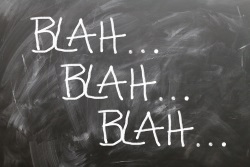 Reading aloud is a great way to edit any type of writing, but I think (for obvious reasons!) it’s especially effective for dialogue. When you read aloud, you can hear your characters’ speech – and you’ll get a sense of whether their words sound stilted, or whether they’re going on and on for ages.
Reading aloud is a great way to edit any type of writing, but I think (for obvious reasons!) it’s especially effective for dialogue. When you read aloud, you can hear your characters’ speech – and you’ll get a sense of whether their words sound stilted, or whether they’re going on and on for ages.
If you’re in a writers’ group, you might even ask other members to read your dialogue aloud – I’ve seen this done with a radio script, for instance. It can be a powerful way to get outside your work and to see how a reader interprets the words you’ve written.
Watch Out For…
Typos and other mistakes. It’s easy to glide over these when you’re reading normally – but if you read out loud, you’re forced to slow down. Try to really see every word.
Out-of-character dialogue. Sometimes, in the heat of composition, you end up writing something that – in retrospect – doesn’t fit with a particular character’s voice or temperament. Slowing down and reading aloud can help these stand out.
#6: Use Alternative Forms of Communication
 While face-to-face conversations are probably going to form the majority of your dialogue, there are plenty of other ways in which two characters can talk.
While face-to-face conversations are probably going to form the majority of your dialogue, there are plenty of other ways in which two characters can talk.
In my trilogy of contemporary fantasy novels, I have quite a few conversations taking place through text, across the internet. I’ve also included forum posts, a handful of emails, and a Skype video call. More prosaically, I have a fair number of conversations taking place on the phone.
You may want to use some of these elements, or similar ones, in your own fiction. Conversations that aren’t face-to-face can throw up some practical difficulties, but they can also open up possibilities that might not have worked otherwise.
Watch Out For…
Not using the medium effectively and plausibly. A text dialogue will obviously read differently from a spoken one; a Skype video call isn’t the same as a phone call. Think through the logistics of the conversation and aim to use limitations to assist with your plot or characterisation.
How you punctuate and tag the dialogue. I avoid using “said” for text conversations, usually opting for “typed” or no tag, just an action or thought. With a phone call, it’s easy to end up with line after line of dialogue and not much supporting action, especially if you’re writing in the first-person or the third-person limited.
Hopefully, I’ve made it clear that there’s no right way to do dialogue – but there are ways to strengthen your natural style, and some pitfalls to avoid if your dialogue is going to ring true.
Enjoyed this post? For more along the same lines, check out Everything You Need to Know About Writing Great Dialogue, which has summaries and links to four more posts about writing dialogue.
About

I’m Ali Luke, and I live in Leeds in the UK with my husband and two children.
Aliventures is where I help you master the art, craft and business of writing.
Start Here
If you're new, welcome! These posts are good ones to start with:
Can You Call Yourself a “Writer” if You’re Not Currently Writing?
The Three Stages of Editing (and Nine Handy Do-it-Yourself Tips)
My Novels

My contemporary fantasy trilogy is available from Amazon. The books follow on from one another, so read Lycopolis first.
You can buy them all from Amazon, or read them FREE in Kindle Unlimited.


Thanks for shaing, nice post!
Great article. Thank you very much.
Thanks for posting! I especially liked the comment about overusing the same action or gesture in dialogue. I tend to do that and it’s easy to miss, even when I’m in the editing phase of my work! (Just because I’m so used to seeing it and don’t realize it’s repetitive.)
Great points.
It’s so easy to do, and easy to miss. My editor is very good at picking up on over-used gestures for me..!
Nice post…
Thanks
Armiadi Asamat’s last blog post ..Lomba Cipta Cerpen Puisi Festival Sastra Islam Nasional 2015
hello Ali! just bummed in here after having a look, i must say your site layout is beautiful and you’ve got a way with words you know.
okay got caught up by these words “there’s no right way to do dialogue – but there are ways to strengthen your natural style, and some pitfalls to avoid if your dialogue is going to ring true.” we had a debate over it months back and finally, reading through this, i’ve got my head cleared. thanks
much love, George.
Ali Luke
Hi. Read your blog post about dialogue and gathered a plethora of information which I posted on my wall as I am polishing my dialogue in my writing. Received your blog via Kevin T. Johns who is a writer in Ottawa, Canada.
I am extremely thankful to your clues about dialogue knowing age, gender, class etc. and especially regarding your insight into the non-verbals. I will use my dialogue “wall of notes” and regard you, Ali Luke, as I am re-writing my “cardboard character dialogue (s)” of each of my characters.
I find 2 elements lacking in my novel writing, first characterization through dialogue, and getting the “patina” of the actual location fitting around my characters. They do not ‘feel’ as though they are in the desert setting, or the Israeli Dan Hotel at 6 p.m. as the Israeli sun dips into the incredibly turquoise-blue Mediterranean. Holding that landscape and making up dialogue to gel together is painstaking and awkward at best when reading what I have written.
Again, I will use your tidbits of info on dialogue. Would enjoy a chat and a word of confirmation in my struggles as an inspiring writer in my senior years. Best.
Sincerely, Bill Valley
Thanks Bill (and thanks Kevin, if you read this, for spreading the word about Aliventures).
I find setting / description a struggle too, and end up working on it a lot when editing. It’s great you’ve pinpointed the areas you need to work on. I think all authors must cringe a bit when reading over their early drafts — I certainly do!
Best of luck with your novel, particularly the rewrites.
Ellipses for trailing off, dashes for interruption. That’s what I’ve been doing, and got a right whacking from a very smart and trustworthy reader who said it should always be a dash.
Style? Opinion?
Yowch! I’ve had a quick look around and I can’t find any of my go-to sources recommending using dashes for everything: ellipses seem to be standard for hesitation or trailing off. Certainly, plenty of published books use them as standard.
The over-use of ellipses can be annoying, though, so if you find you’ve got a fair number in one scene, you might want to cut back.
I suppose all of us, as writers and as readers, have some quirks and preferences on how we like to do things. In this case, though, I think your reader’s preference isn’t matching up with mainstream practice.
I use the same convention—dashes for when they’re cut off, ellipses when they trail off naturally. When I first started writing and got my first computer, MS Word didn’t like dashes at all and refused to orient the smart quotes correctly if I wrote —”. I asked my mom about this and she said it wasn’t grammatically correct. Always drove me nuts—an ellipsis just doesn’t feel like a character is being “cut off” to me, it’s much more gentle. So thanks for this post—validation at last! Lol
Emma’s last blog post ..Observations of Star Birth
Can you give an example as to what bad dialogue would be? When I write dialogue I often find myself comparing how I write certain things to how others write. Are there any things that writers do, while writing dialogue, that are mainly just stylistic choices, rather than right or wrong? All of the advice you gave is good, I just need to see examples of what bad dialogue looks like so I will really be able to pinpoint whether or not I am writing correctly, incorrectly or just with my own style. Thanks!
This was very helpful
Hey,
So I’m new to writing, attempting my first 20-30000 word story as we speak, and my question is about large conversational dialogue. I know its a taboo thing to have characters talk an extensive amount, but in one or two scenes in this story it needs to happen to make the narrative arc flow. How can this be done without over doing it or bombarding the reader with he said she asked, and still make the story flow, its my biggest dilemma.
Welcome to the wonderful world of writing, Alex! 🙂
This is a tricky one. There are a few things that you could try:
#1: Use indirect dialogue. Instead of actually writing out what the characters say, you can summarise. For instance: Jacob told Winifred how he’d lost his job — after only two days — through no fault of his own.
#2: Break up long speeches. I think it’s fine for a conversation to go on for a while, but if a character is speaking for a very long time, you might want to have another character come in with a question or interruption. (Don’t overdo it, though — breaking up the dialogue too much can also be annoying.)
#3: Don’t sweat it! Write it however it comes out, and think about whether it’s an excessive amount of dialogue when you redraft. 🙂 (I tend to write a lot of dialogue in my first drafts, and cut it or put in more narrative around it when I redraft.)